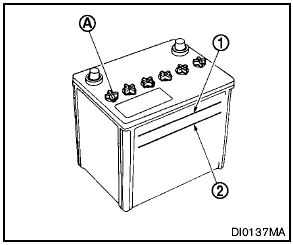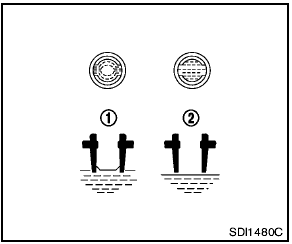Battery
- Keep the battery surface clean and dry.
Clean the battery with a solution of baking soda and water.
- Make certain the terminal connections are clean and securely tightened.
- If the vehicle is not to be used for 30 days or longer, disconnect the negative (−) battery terminal cable to prevent discharging it.

- Do not expose the battery to flames or electrical sparks. Hydrogen gas generated by the battery is explosive.
Do not allow battery fluid to contact your skin, eyes, fabrics, or painted surfaces. After touching a battery or battery cap, do not touch or rub your eyes. Thoroughly wash your hands. If the acid contacts your eyes, skin or clothing, immediately flush with water for at least 15 minutes and seek medical attention.
- Do not operate the vehicle if the fluid in the battery is low. Low battery fluid can cause a higher load on the battery which can generate heat, reduce battery life, and in some cases lead to an explosion.
- When working on or near a battery, always wear suitable eye protection and remove all jewelry.
- Battery posts, terminals and related accessories contain lead and lead compounds. Wash hands after handling.
- Keep the battery out of the reach of children.

Check the fluid level in each cell. (Remove the battery cover if it is necessary.) It should be between the UPPER LEVEL 1 and LOWER LEVEL 2 lines.
If it is necessary to add fluid, add only distilled water to bring the level to the indicator in each filler opening. Do not overfill.

1. Remove the cell plugs A .
2. Add distilled water up to the UPPER LEVEL 1 line.
If the side of the battery is not clear, check the distilled water level by looking directly above the cell; the condition 1 indicates OK and the conditions 2 needs more to be added.
3. Tighten cell plugs A .
Vehicles operated in high temperatures or under severe conditions require frequent checks of the battery fluid level.
See also:
Oil viscosity
The engine oil viscosity or thickness changes
with temperature. Because of this, it is important
to select the engine oil viscosity based on the
temperatures at which the vehicle will be operated
...
Rear-facing child restraint installation using LATCH
Refer to all Warnings and Cautions in the “Child
safety” and “Child restraints” sections before
installing a child restraint.
Follow these steps to install a rear-facing child
restraint ...
2009 Nissan Rogue
Car names are fun to play with. Take the 2009 Nissan Rogue, for example. The
Rogue doesn't play by the rules; It colors outside the lines and lives outside
the box. I could go on and on. In this c ...
